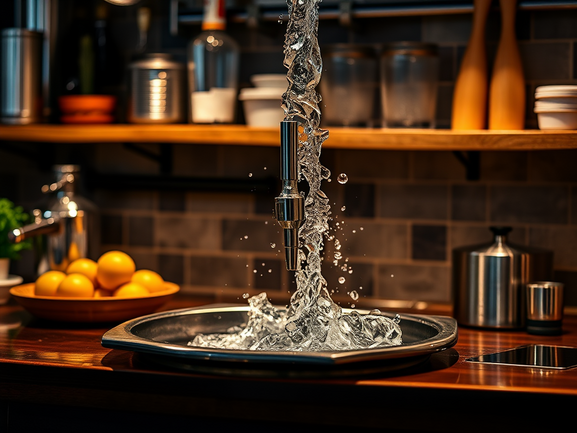From Hidden Contaminants to Crystal-Clear Kitchens: The Case for RO with Well Water
The moment you turn on a tap in a busy restaurant kitchen, you expect water that’s not just clear, but pristine—no off-flavors, no rusty discoloration, no lurking nitrates ready to undermine food safety. Yet, when your source is a private well, unseen enemies like iron, manganese, and nitrates can slip through aging pipes and soil fractures, turning innocuous water into a liability. Picture a chef whisking a velouté sauce only to find tiny rust specks swirling at the bottom of the pot, or a barista’s meticulously crafted latte clouded by sediment. That’s where a heavy-duty reverse osmosis system comes into play, acting as an invisible shield that transforms suspect well water into a reliable culinary partner. According to Crystal Quest, even modest commercial operations can demand over 200 gallons per day of pure water to maintain food safety standards and flavor consistency (Crystal Quest).
At the heart of this transformation lies a robust pre-treatment suite: high-capacity sediment filters to trap grit and rust flakes before they can scuff or clog membranes, and iron pre-filters engineered to remove microscopic iron particles that cause staining and off-tastes. These modules, like those offered in US Water Systems’ commercial suites, fit seamlessly into busy kitchen footprints, protecting the RO membrane from the very first drop. By intercepting contaminants early, membranes enjoy extended lifespans, and chefs gain the confidence that every splash of RO water—from poaching broths to final plate sprays—is free from particulate worries (US Water Systems).
But sediment and iron aren’t the only culprits. Bacteria can proliferate unnoticed in well lines, especially during warmer months. Integrating UV sterilization as an additional stage vanquishes microbial threats, ensuring water that not only looks clear but meets rigorous safety thresholds. Complementing UV with a permeate pump amplifies efficiency: these pumps recover up to 50% more purified water while reducing wastewater by nearly 80%, a game-changer when hundreds of gallons pass through your kitchen every day. Oceanic Water’s 100-GPD six-stage system highlights just how much waste can be cut without compromising output (Oceanic Water).
Once treated, that surge of ultrapure water needs smart storage. Compact atmospheric tanks slide neatly under counters, delivering zero-TDS water for plating delicate sauces and beverages, while larger bladder tanks store reserve volumes for peak service periods without sacrificing pressure. Whether you choose a 15-gallon bladder or a 30-gallon atmospheric design, the goal remains the same: uninterrupted flow even when every faucet, espresso machine, and auto-fill nozzle calls for water at once. By understanding how reverse osmosis water filtration works, kitchen managers can fine-tune system layout to match demand, avoid downtime, and serve up perfection with every sous-vide bath, espresso pull, and hand-washing cycle.
In my experience, investing in commercial-grade RO for well water isn’t just a technical upgrade—it’s a statement that quality matters down to the very last drop. From unfiltered hazards hiding underground to crystal-clear kitchens where every sauce, souffle, and shot of espresso shines, RO is the linchpin of food safety, consistency, and peace of mind.
Reverse Osmosis Unveiled: Transforming Tough Well Water into Kitchen-Ready Purity
It’s almost magical: water that once oozed iron tints and gritty sediment becomes so pure you swear it must be bottled spring water. Yet for commercial kitchens drawing on challenging well sources, that magic hinges on a sequence of carefully orchestrated treatment stages. Imagine an old farmhouse well brimming with hard minerals and organic debris; without intervention, those components damage membranes, clog lines, and muddy flavors. Enter reverse osmosis, the silver bullet that strips out up to 99% of dissolved solids, but only after a surgical pre-treatment process.
First, high-capacity sediment filters intercept particles down to five microns, stopping sand, silt, and rust flakes before they nick the delicate RO membrane. Then, dedicated iron pre-filters trap ferric hydroxide and microscopic rust, preventing unsightly staining on glassware and cookware. Next, water softeners neutralize hardness ions—calcium and magnesium—ensuring smooth operation of each stage. Activated carbon blocks then scrub away chlorine and organic chemicals that could degrade performance and impart off-flavors. Anti-scaling phosphate cartridges dose water with scale inhibitors to keep minerals from building up on membranes. This entire pre-treatment train operates in concert to protect downstream stages, maintaining consistent performance even under heavy use (US Water Systems).
Once the water arrives at the RO membrane, pressure forces it through a semi-permeable barrier that rejects dissolved salts, nitrates, lead, and countless other contaminants. The result? Permeate water so pure it’s nearly indistinguishable from deionized water, delivering a blank canvas for any culinary application. But savvy operators often add polishing stages: granular activated carbon (GAC) to catch any residual organics, and ultraviolet (UV) purification to annihilate bacteria and viruses, ensuring every pour meets HACCP guidelines. For kitchens seeking efficiency without compromise, integrating a permeate pump slashes wastewater by up to 80% while boosting clean water output by 50%, a balance that makes both environmental and economic sense (Oceanic Water).
What results is nothing short of transformational: crystal-clear water that enhances tea and coffee extraction, brightens flavors in sauces, and preserves the integrity of sous-vide and steam applications. By taking full advantage of RO’s power, chef-owners and kitchen managers can move beyond compromise, ensuring every dish reflects the true taste of their ingredients, unmasked by unwanted minerals and pollutants. It’s the kind of purity that matters every time a customer raises a glass or savors a spoonful of consommé.
Engineering Excellence: Designing and Sizing Your Commercial RO System
Designing a commercial RO system is an exercise in precision and anticipation: you’re calculating not just how much water a kitchen uses, but how demand spikes and lulls with every service period. A small café might hover around 200 gallons per day, whereas a high-volume bistro can surge well past 600 in a single lunch rush. GPD ratings—gallons per day—are the pulse of system sizing, guiding equipment selection from compact under-counter units to skid-mounted rack systems (GPD in RO Meaning and Importance).
Peak-demand planning begins with mapping your service flow: espresso machines firing in the morning, soups simmering at midday, cocktail stations swirling well into the evening. To meet these fluctuations, engineers blend continuous-flow RO membranes with buffer storage. Compact units deliver up to 300 GPD in under-sink footprints, ideal for confined kitchens. For broader operations, custom skid-mounted racks house large-diameter membranes and multi-stage pre-treatment trains, all plumbed to deliver thousands of gallons daily without pause (Crystal Quest).
Below is a simplified sizing guide illustrating typical kitchen types and recommended system capacities:
| Kitchen Type | Average Daily Usage (GPD) | Suggested RO Capacity | Pre-Treatment Modules |
|---|---|---|---|
| Small Café | 150–250 | 300 GPD Compact RO | Sediment, Carbon Block |
| Mid-Size Bistro | 300–500 | 500–750 GPD Skid Unit | Sediment, Iron, Softener, Carbon |
| Large Restaurant | 600–1,000+ | 1,000–1,500 GPD Custom Rack | Full Pre-Treatment Train + UV |
Beyond capacity, water quality at the inlet shapes pre-treatment needs. Wells plagued by iron demand iron filters; high hardness calls for water softeners; organic-rich sources benefit from backwashing carbon vessels. Anti-scaling phosphate cartridges fend off mineral buildup, preserving membrane permeability. Integrating a UV stage is a must when microbial counts are suspect. Finally, adding a permeate pump refines system efficiency, cutting brine flow and stretching membrane life, a critical consideration when downtime translates directly to lost covers and revenue.
By following these guidelines and adjusting for local water characteristics, kitchen professionals can engineer RO systems that fit space constraints, handle daily routines, and adapt to peaks without missing a beat. The result is a tailored solution that empowers chefs to focus on creativity rather than clogged filters and inconsistent pours.
Operational Mastery: Maintenance, Monitoring, and Maximizing ROI in Kitchen RO
Nothing undermines chef confidence more quickly than a sudden drop in water pressure or cloudy ice clogging the garnish bar. That’s why operational mastery—consistent maintenance, vigilant monitoring, and strategic upgrades—is the lifeblood of a kitchen RO program. Regularly flushing membranes with a low-pressure rinse removes scale and organic fouling, extending membrane life by as much as 30% according to Crystal Quest’s guidelines (Crystal Quest). Swapping sediment and carbon prefilters every six months keeps flow rates high and tastes fresh.
Weekly TDS readings provide real-time alerts to shifts in water quality. Armed with a reliable TDS meter, staff can detect rising mineral loads before they impair membrane performance, following best practices outlined in the ultimate TDS meter guide. Under-sink system basics—including pressure checks and leak inspections—add another layer of assurance; operators can reference under-sink RO fundamentals for step-by-step care instructions.
To boost ROI, consider integrating smart sensors and automation. Permeate pumps dramatically reduce wastewater, translating to up to 20% savings on water bills. Pairing these pumps with food-service–grade RO units, such as those in US Water Systems’ specialized food & beverage lineup, ensures throughput and reliability. Maintenance contracts with certified technicians minimize unexpected downtime, while remote monitoring dashboards let managers flag issues before service disruption. The outcome? Your kitchen’s water program shifts from a cost center to a value driver, underpinning operational efficiency and customer satisfaction.
It’s a subtle alchemy: combine proactive upkeep with targeted upgrades, and you’ll see clearer ice, faster prep sink recovery, and consistent flavor extraction across every station. In the relentless pace of commercial kitchens, that reliability isn’t a luxury—it’s an operational imperative.
Key Takeaways & Final Words
Commercial kitchens thrive on unwavering consistency, and today’s well-water reverse osmosis systems deliver precisely that—up to 1,500 gallons per day in configurations as compact as under-counter units or as robust as skid-mounted racks. Combining rugged pre-treatment modules with high-flux membranes, these systems strip away sediment, iron, hardness, and bacterial threats, providing a blank canvas for every culinary creation. Pre-treatment suites from US Water Systems protect against sediment and iron, while APEC’s compact commercial RO units prove that premium performance can fit beneath even the tightest counters (APEC Water).
Beyond numbers, RO systems instill confidence in line cooks, sous-chefs, and pastry artists alike. Clear ice, bright broths, and spotless glassware are no longer aspirational goals—they become daily standards. As one chef raved after installing Oceanic Water’s six-stage system with a permeate pump, “Our sauces have never tasted purer, and I don’t worry about midday slowdowns anymore”—a testament to the transformative power of well-designed RO (Oceanic Water).
From initial water testing and GPD calculations to membrane selection, storage tank configuration, and maintenance protocols, every step plays a role in crafting a system tailored to your kitchen’s rhythm. Dive deeper into each phase—from sediment traps to final polishing—by exploring Typical RO System Stages Explained. With the right design, vigilant care, and strategic upgrades, your kitchen moves from uncertainty to unwavering reliability, ensuring that every drop you pour is a drop of culinary confidence.
Sources
- APEC Water – Compact Commercial Detail
- Crystal Quest – Commercial Reverse Osmosis Systems
- Oceanic Water – 100 GPD 6-Stage Reverse Osmosis Water Filtration System
- OsmosisInfo – GPD in RO Meaning and Importance
- OsmosisInfo – Understanding Reverse Osmosis Water Filtration
- OsmosisInfo – Typical RO System Stages Explained
- US Water Systems – For Business Commercial Reverse Osmosis
- US Water Systems – For Business Industries We Serve Food and Beverage

Dr. Tina M. Nenoff is a senior scientist and Sandia Fellow at Sandia National Laboratories, renowned for her pioneering work in nanoporous materials. Her research focuses on the chemistry of confinement and reactivity of ions and molecules within these materials, leading to significant advancements in environmental remediation and energy applications. Notably, she played a crucial role in developing crystalline silicotitanates used to remove radioactive cesium from contaminated seawater following the Fukushima Daiichi nuclear disaster.


